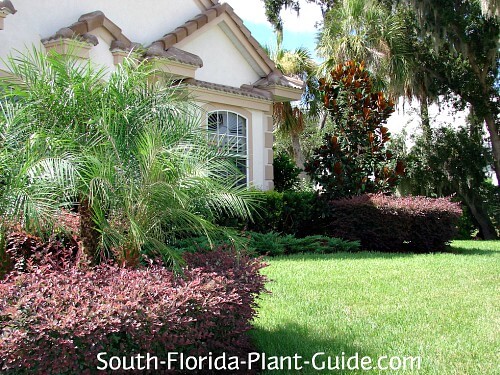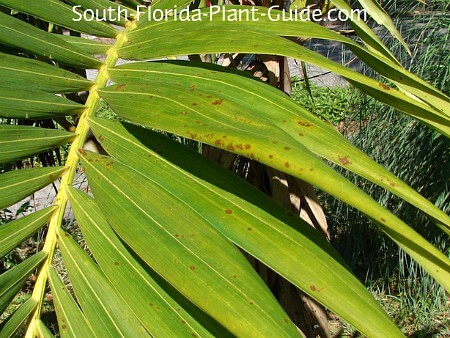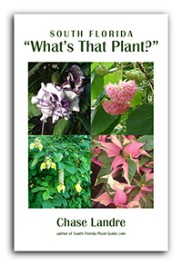Cold Protection for
South Florida Plants
Every winter we worry about cold protection for our plants. Plants in our subtropical climate love the heat. South Florida's short winters sometimes take a toll on these tender and beautiful plants.

On this page you'll find ways to protect your plants from cold...
...and methods of dealing with cold damaged plants.
Cold protection tips for plants
In a "normal" winter most South Florida landscape plants, when placed correctly, do just fine. A few may lose some leaves, but flush out again in spring.
But some winters are harsher than others. No matter how diligent you are about cold protection, you may lose some plants to winter weather. And even cold hardy plants can sustain damage.
Plant choice
If you live in Zone 9B, your best bet is to make winter hardy plants a staple of your landscaping.
Sure, you can have some tropicals, but they'll need to be strategically placed out of the worst weather. You may also need to wrap or cover them more than residents of Zone 10.
See the Planting Zone Map to see what kind of drop in temperatures you can expect.
The Plant Pages tell you the ideal zone(s) for each plant so you can choose wisely.
What to expect from a South Florida winter
Most winter temperatures range between 40 and 70 degrees (F), with short colder dips that can last several hours.
Cold events typically last one to a few days in a normal year. January and February are usually the chilliest months.
Frontal systems typically arrive in three stages: precipitation, wind and then cold.
As the front approaches, it brings with it wind and often rain. The rain ends quickly but the winds can persist until the front has fully passed, creating a drying effect on plants and soil.
After the front passes is when the temperature usually drops and freezing can occur.
Plant placement
Cold fronts generally come from the northwest or west. Placing tropicals on the south and east side of your home makes use of one of the best cold barriers - the house itself.
For big trees or palms, place them in areas shielded by large, more cold-tolerant trees.
Understory plantings with tree canopy coverage helps insulate the area by keeping it a bit warmer and protected from frost.
Fences or cold hardy hedges on the north or northwest side of more tropical plants can act as a buffer against cold winds.
Watering
There are two basic reasons to water before a cold night:
- Drying winds take more of a toll on too-dry plants.
- Watering early in the day warms the soil and helps the plant survive the cold.
Unlike people, plants don't have body heat.
Watering a plant in the morning before a predicted cold night allows the soil to absorb warmth from the sun and warmer daylight air.
If you then cover a plant for a chilly night, the covering helps capture warmth from the soil.
You've probably seen TV news footage of farmers running their irrigation over crops throughout the night for cold protection. Don't do this! It's very tricky to get right.
The irrigation forms a layer of water and then another of ice (as the temperature drops). For it to work, the irrigation (started early in the day of a predicted evening frost) must remain on well into the next day until all the ice that's formed has melted.
Covering
The idea is to keep frost from touching the plant.
Forget the sheets - a sheet does nothing to protect a plant from frost or cold.
The best cover for cold protection? Frost cloth, a thick insulated material available from nurseries and home centers.
You can substitute a thick quilt or blanket, though frost cloth gives the best cold protection and it's more lightweight.
Bring the frost cloth or covering all the way to the ground around shrubs and small plants. If you can, secure with concrete blocks or bricks all the way around the plant's base to keep the covering from blowing off and to trap the soil's warmth.
Do NOT use plastic to cover plants. Bad idea. It doesn't "breathe" and can create even colder temperatures underneath it.
Remove coverings in the morning.
Tie up the fronds of a small or young palm and wrap the "head" with frost cloth, a heavy blanket or several layers of burlap. For small trees, wrap the entire head.
What to do if your plants get damaged by cold
WHATEVER YOU DO...
- Don't prune anything! The more foliage a plant has, damaged or not, the better insulated it will be. Damaged leaves will bear the brunt of any future cold event. Pruning encourages new growth - tender new shoots that emerge can be hurt by the next cold snap.
- Don't fertilize! This also encourages tender new growth.
If a plant is hurt by the cold, it may display one or several symptoms:
Leaf drop - Many tropicals like crotons will drop some of their leaves - or even all of them - in an extra cold winter. Don't worry...new growth will emerge in spring.
Foliage burn - A very common form of damage, this is basically freezer burn on plants. Leaves or portions of them may turn tan, brown or even black and very wilted.
Sometimes just the tips of the leaves, such as on the fronds of a pygmy date palm, turn brown - usually from wind burn. In spring you can cut off any damaged fronds.
Fungus - Plants suffer stress from cold and may show signs of plant fungus - often developing brown spots on leaves as on the adonidia palm frond pictured below. The brown spots go all the way through to the leaf's undersides.

Apply a systemic fungicide after the cold event is over.
Spray trees,
shrubs and other plants with a fungicide like liquid copper.
Palms may also need an additional drench to the center bud (where new frond "spears" emerge).
You can also spray your plants just before winter sets in to strengthen their resistance to fungus.
Dead...or not? To see if your plants are still alive, scratch a stem with your fingernail. If there's green on the stem where you scratched, the plant is still living.
The Make-It or Break-It mindset
Many of us do the minimum and just hope for the best. If this sounds like you, here's your cold protection checklist:
√ place plant correctly
√ water in the A.M.
√ cross fingers
Take a break!
The ultimate guide to low-maintenance plants
and landscaping!
An ebook by
Chase Landre
author of
South-Florida-Plant-Guide.com
Learn more!
Get a greener thumb!
Want to learn more about South Florida planting, watering, fertilizing and dealing with weeds and pests?
See our Gardening How-To section for answers!
Get instant curb appeal!
An ebook by
Chase Landre
author of
South-Florida-Plant-Guide.com
Learn how to get instant curb appeal with fast growing plants and landscaping techniques!



